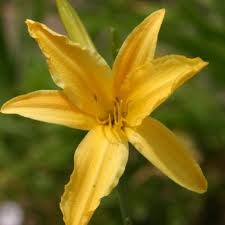Hemerocallis
This group consists of 15 species (as well as numerous hybrids) of deciduous or evergreen, perennial plants commonly known as Daylilies. Daylilies belong to the Lily family, Liliaceae, but are not true Lilies. Their Lily-like flowers usually last only a day, thus the common name, Daylily, but are borne in succession over a period of two to six weeks during the summer. Daylilies are natives of Japan and other eastern countries and southern Europe; some kinds are naturalized in North America. Daylilies range in height from compact plants, 12 to 15 inches high, to large plants up to 5 feet. They have long, slender, arching leaves, 1 to 2 feet in length. Their flower clusters are held above the leaves on long stems. Some hybrids produce up to 50 buds on each flower stalk. The flower colors of the species come in vibrant shades of yellow, orange, and red, with a much more varied color selection in the hybrids. Plants have been developed with flowers in cream, gold, scarlet, pink, apricot, purple, violet, and plum, as well as bicolor combinations with banded or streaked petals. Some flowers are fragrant and some have ruffled petals. There are also hybrids, which repeatedly bloom throughout the summer; they bloom early, then after a short rest, bloom again, constantly repeating the process. Daylilies are suitable for growing in flowerbeds and containers and as ground covers. Daylilies also make excellent cut flowers. They will bloom in the evening if refrigerated during the day. A few plants will be described in the following section. H. 'Siloam Virginia Henson' is a shorter variety with broadly strap-shaped, mid-green leaves. Its round flowers have ruffled petals, which are creamy-pink with rose-pink bands and green throats. H. 'Jolyene Nichole' has attractive blue-green leaves and rounded, rose-pink flowers. The edges of the petals are ruffled. H. 'Super Purple' has striking, red-purple flowers with lime-green throats. The velvety petals are ruffled along the margins. H. 'Betty Woods' has beautiful yellow, double flowers, which somewhat resemble Peonies.
Pot Cultivation
Daylilies are hardy from zones 3 to 10. They are tough, adaptable, vigorous-growing plants that will thrive in nearly all kinds of soil; however, the best is soil that is moist, but well-drained, fertile and humus-rich. If your soil is light, add compost, peat moss or old manure. Mulch the soil with compost or decayed manure in the spring and in the fall, for protection in cold-winter regions. Choose a sunny or lightly shaded location for your plants. The best flowers will be produced when they are planted in a sunny location, unless you live in a very hot climate; in this case, choose a lightly shaded area. The tuberous roots or grown plants may be planted at anytime during the growing season, although spring and early fall is best. The crowns should be placed close to the surface of the soil and spaced one to three feet apart. Daylilies do best when watered regularly and lightly fertilized once in a while. These plants will need protection from slugs and snails, especially in the spring. Any abnormally swollen buds that appear in late spring or early summer should be plucked off and discarded, since this may be an indication that the plant is infected by Hemerocallis gall midges.
Propagation
Daylilies are easily increased in the spring or fall by lifting and dividing the tuberous roots. Seeds may also be sown as soon as they are ripe. Young plants should be wintered in frost-free conditions under glass.
 |
|
H. flava |
|
VARIETIES
- H. aurantiaca;
- H. Dumortieri;
- H. flava;
- H. fulva;
- H. lilioasphodelus.
H. littlelila
H. luteola;
- H. siroliver
H. Tom Wise





